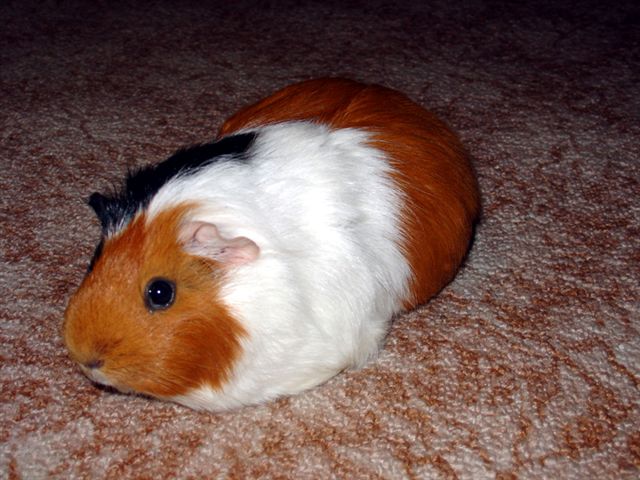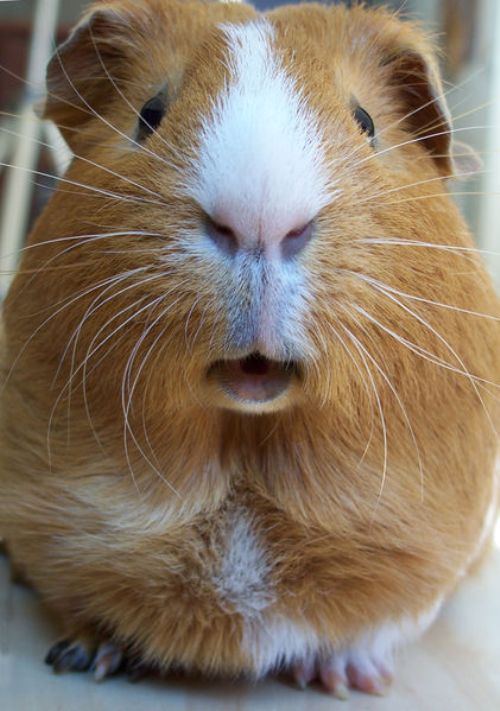

 :: How I Get Along With Everyone
Else!
:: How I Get Along With Everyone
Else!
 Guinea pigs have three main
interactions with humans.
The first one is the guinea pig being used as a
household pet.
They make great companions for children because
of their docile nature.
They rarely bite or scratch when they are held
and they are very sociable.
The second use for guinea pigs by humans is the
use for food.
In
Guinea pigs have three main
interactions with humans.
The first one is the guinea pig being used as a
household pet.
They make great companions for children because
of their docile nature.
They rarely bite or scratch when they are held
and they are very sociable.
The second use for guinea pigs by humans is the
use for food.
In
 In a household some pets can learn
to get along with guinea pigs.
Dwarf rabbits, dogs, and cats are examples, but
in some cases they will claw or bite the guinea pig.
Gerbils, deer mice, and hamsters do not get along
with guinea pigs.
They speak another “language,” and the guinea pig
will not defend itself against these more aggressive
animals.
In a household some pets can learn
to get along with guinea pigs.
Dwarf rabbits, dogs, and cats are examples, but
in some cases they will claw or bite the guinea pig.
Gerbils, deer mice, and hamsters do not get along
with guinea pigs.
They speak another “language,” and the guinea pig
will not defend itself against these more aggressive
animals.
Guinea pigs are preyed upon by other organisms. In nature these predators include snakes, foxes and bird of prey. The guinea pig is a consumer, placing it closest to the producers in the food web. It is a food source for secondary consumers and tertiary consumers.
Guinea pigs encounter a number of diseases.
Some of the most common ones are bacterial and
fungal diseases. One is called streptococcal pneumonia.
Its pathology consists of the guinea pig’s lungs
filling up with fluid and meningitis is commonly seen
with this disease.
Streptococcal pneumonia is passed by direct
contact and carriers for the disease include rats and
humans.
Another disease is
Bordetella pneumonia.
The guinea pig develops lesions and will lose a lot of
weight. The
animal will also sneeze a lot and have nasal discharge.
Cer vial
Lymphadenitis is yet another disease that affects guinea
pigs.
Basically this disease entails lumps; the guinea pig’s
lymph nodes become very large and develop abscesses (a
collection of pus). A strange disease for the guinea
pigs is Pododermatitis which is also known as ‘bumblefoot.’
This occurs in guinea pigs that live on wire
floors that are unsanitized and rough.
Lesions will develop but can be properly cared
for (simply by being put in a cage with soft bedding) so
the guinea pig doesn’t become more infected.
The best way to care for a guinea pig though is
to prevent a disease or sickness before it happens.
Proper diet and a tidy living space will not only
keep a guinea pig healthy, put happy too.
vial
Lymphadenitis is yet another disease that affects guinea
pigs.
Basically this disease entails lumps; the guinea pig’s
lymph nodes become very large and develop abscesses (a
collection of pus). A strange disease for the guinea
pigs is Pododermatitis which is also known as ‘bumblefoot.’
This occurs in guinea pigs that live on wire
floors that are unsanitized and rough.
Lesions will develop but can be properly cared
for (simply by being put in a cage with soft bedding) so
the guinea pig doesn’t become more infected.
The best way to care for a guinea pig though is
to prevent a disease or sickness before it happens.
Proper diet and a tidy living space will not only
keep a guinea pig healthy, put happy too.
In the disease section, it may seem that all bacteria are bad for guinea pigs, but that’s not true at all! The guinea pig has a cecum, which is a large, thin-walled sac located at the crossroads of the small and large intestine. This sac contains up to 65% of gastrointestinal contents. In the cecum there are bacteria and protozoa to aid in the digestion of foods that the guinea pig has eaten! E. coli also lives inside the intestine of a guinea pig. For these bacteria and protozoa to do their job properly, they need fiber. Without this essential item, the gastrointestinal tract would slow down, changing the bacterial and fermentation population. Over time this can lead to the guinea pig having indigestion.
Go to Habitat to learn more about guinea pig survival!



 :: LINKS
:: LINKS



 :: Learn More About:
:: Learn More About:

